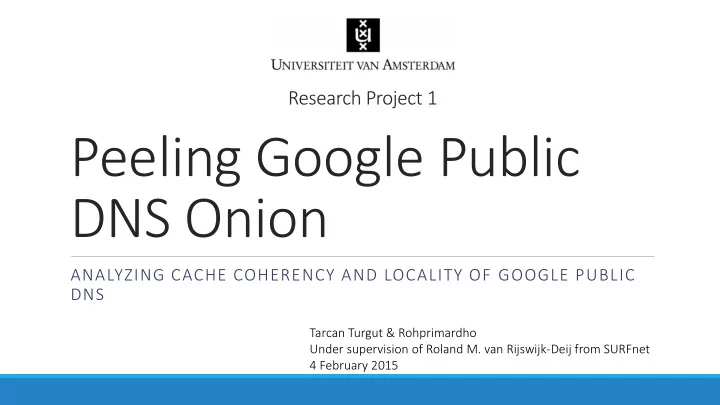

Research Project 1 Peeling Google Public DNS Onion ANALYZING CACHE COHERENCY AND LOCALITY OF GOOGLE PUBLIC DNS Tarcan Turgut & Rohprimardho Under supervision of Roland M. van Rijswijk-Deij from SURFnet 4 February 2015
Research Questions Is there a single shared cache? ◦ Does the authoritative name server receive more than one query? ◦ Is there any delay while distributing the cache entry to other locations? ◦ Is level 1 cache identical? ◦ Does Google Public DNS respect the TTL set by the authoritative nameserver? Where is the query to the authoritative name server coming from?
Google Public DNS DNS ◦ Alternative for DNS provider Location ◦ Anycast routing ◦ AS15169 Cache ◦ 2 levels ◦ Popular and unpopular domain names
General Topology BIND RIPE Atlas probes
General Topology Source: RIPE Atlas website
Origin of the DNS Queries Mapping the flow of the query Probe Location Query Source Use RIPE Atlas probes to send DNS queries Bangladesh Singapore ◦ Check the source of the query in the log Saudi Arabia Belgium ◦ 1 probe each country Argentine Chile Conclusion Ecuador USA ◦ Query originates in Google Public DNS server Canada USA close to the client Algeria Belgium ◦ Hints: no global single shared cache around the world South Africa Belgium Finland Finland The Netherlands Belgium Russia Finland
Round Trip Time Compare RTT between two areas to see possible Country Name Average RTT (in ms) performance penalty Indonesia 17 Traceroute to 8.8.8.8 Phillipines 45 ◦ Southeast Asia and Western Europe (each 5 countries) Vietnam 40 ◦ 5 randomly picked RIPE Atlas probes Singapore 3 Latency is an order of magnitude higher in Southeast Malaysia 64 Asia than in Western Europe The Netherlands 5 France 3 Germany 2 Switzerland 2 Luxembourg 25
Edge Router to AS15169 To see if they all use the same edge router and if the query also came from the same origin Same setup as the previous ◦ Southeast Asia and Western Europe (each 5 countries) ◦ 5 randomly picked RIPE Atlas probes ◦ Traceroute to 8.8.8.8 and also send DNS query Result ◦ Edge router differs based on which RIPE Atlas probes were used ◦ The query not always came from the same location
Edge Router to AS15169 Conclusion ◦ Anycast ◦ Google has some kind of mechanism that takes care of the query inside AS15169
Two Levels of Caching Level 1 cache – Most popular names (a small per-machine cache) Level 2 cache – Unpopular names (partitioned by names) Each level contains a pool of machines
Is Level 1 cache identical per location? Flush Cache Tool - Bug! They are working on it!
Global Coherency of Level 2 Cache
Global Coherency of Level 2 Cache Result: There is NOT a single globally shared cache.
Does Google respect TTL set by authoritative name servers? Google does NOT modify TTL values unless it is more than 6 hours An answer for an A record with default TTL set to 1 day (86400 secs): ;; ANSWER SECTION: day.uk.inspectorgoogle.net. 21599 IN A 178.62.38.140
Level 2 cache coherency in a single location
Level 2 cache coherency in a single location Query ID Timestamp Cache ID Google Resolver IP TTL 1 01:50:02 1 2a00:1450:400c:c05::153 300 2 01:50:12 2 74.125.181.83 300 3 01:50:22 1 Cache Response 280 4 01:50:32 2 Cache Response 280 5 01:50:42 2 Cache Response 270 6 01:50:52 3 2a00:1450:400c:c05::153 300 7 01:51:02 2 Cache Response 250 8 01:51:12 2 Cache Response 240 9 01:51:22 1 Cache Response 220 10 01:51:32 3 Cache Response 260 11 01:51:42 4 74.125.17.209 300
Level 2 cache coherency in a single location Finding: TTL values decrease gradually till very low values Query ID Timestamp Cache ID Google Resolver IP TTL 1 01:50:02 1 2a00:1450:400c:c05::153 300 9 01:51:22 1 Cache Response 220 21 01:53:22 1 Cache Response 100 26 01:54:13 1 Cache Response 50 30 01:54:53 1 Cache Response 10 Implication: Google does not evict RRs from cache before TTL expires - Cache is big enough
Level 2 cache coherency in a single location Finding: There seems more than 1 cache in a single location. Query ID Timestamp Cache ID Google Resolver IP TTL 1 01:50:02 1 2a00:1450:400c:c05::153 300 2 01:50:12 2 74.125.181.83 300 3 01:50:22 1 Cache Response 280 4 01:50:32 2 Cache Response 280 Implication: Level 2 cache is fragmented as opposed to Google’s statement.
Level 2 cache coherency in a single location Finding: The cache responses are coming from multiple caches. Cache ID Occurence 1 10 2 11 3 3 4 2 Implication: Possibly behind a load-balancer - Not found a regular pattern pointing an algorithm such as round-robin
Level 2 cache coherency in a single location Finding: 1st and 6th queries are handled by the same Google resolver IP Query ID Timestamp Cache ID Google Resolver IP TTL 1 01:50:02 1 2a00:1450:400c:c05::153 300 6 01:50:52 3 2a00:1450:400c:c05::153 300 Implication: “Egress IP addresses are shared by multiple resolver” [says Google ] - A mapping between resolver IP and the cache is N/A
Level 2 cache coherency in a single location Finding: Ghost cache Query ID Timestamp Cache ID Google Resolver IP TTL 1 07:20:01 1 74.125.181.86 300 (300) 2 07:20:11 1 Cache Response 290 3 07:20:21 2 74.125.181.80 300 4 07:20:31 3 74.125.47.83 300 5 07:20:41 4 74.125.47.80 300 7 07:21:01 Unknown Cache Response 250 24 07:23:52 Unknown Cache Response 80 Implication: Not available. Extra information needed by Google!
Conclusion The queries to an authoritative name server originates in the Google datacenter where the query is received Not a globally centralized Level 2 cache. Expensive! Fragmented Level 2 cache in a single location may increase the cache miss rate, consequently the response time Level 2 cache behavior seems the same and our results are similar in different locations of Google, TTL values, frequency of originating query and time-of-day
Future Work Hints of possible performance penalty. (Google vs. Local resolvers) Need more information to deduce further ◦ Google : “We cannot disclose technical details”
Questions?
Recommend
More recommend